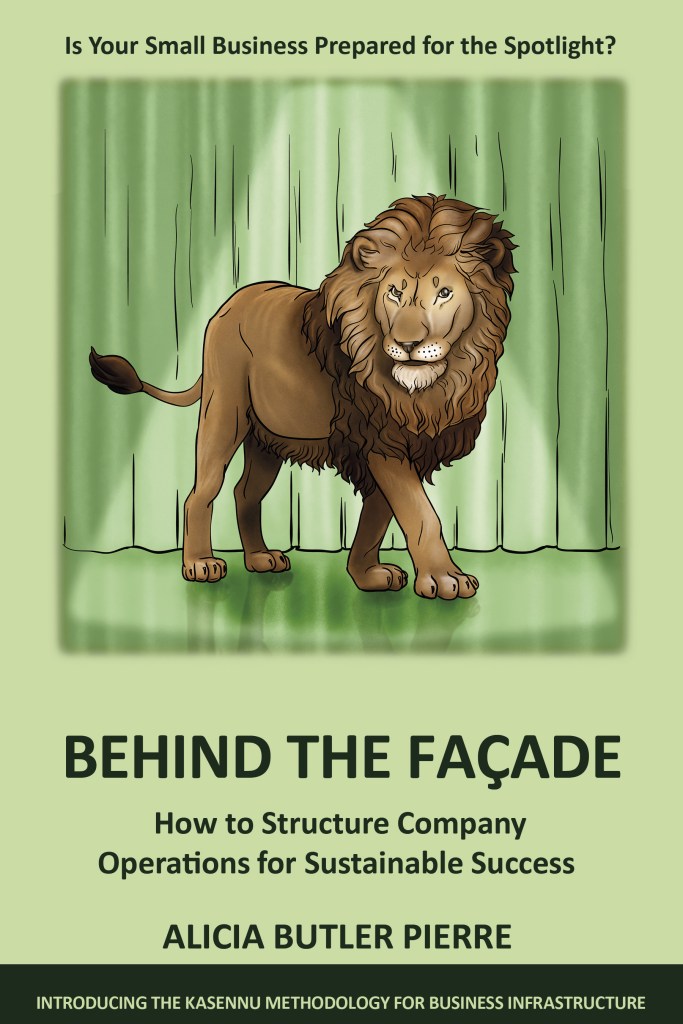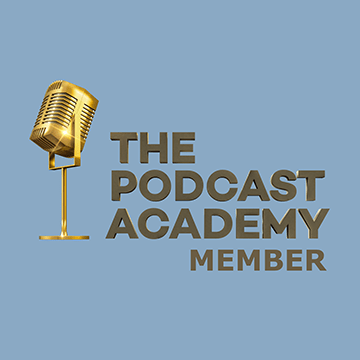Transcript
Is your small business growing faster than you can keep up with? It might be time to grow your team, document key processes, and make sure you’re using the right technologies to scale up operations. In other words, your company might need business infrastructure. At Equilibria, Incorporated we specialize in building business infrastructure.

Equilibria is proud to sponsor this special season which features an AI audio conference to advance your knowledge of business infrastructure. We hope you enjoy this episode!
Welcome to Season 22 of the Business Infrastructure podcast. I’m Alicia Butler Pierre and on this show, we share operational tips, strategies, and tactics to help you cure any back-office blues you might be experiencing.
It’s now time for the next presentation of our AI audio conference. As a reminder, I’ll provide live commentary so that you can follow along.
In the last episode, you heard from Jim Stroud and how he, as a recruiter, uses Perplexity to assist him in researching relevant topics he can write about. Our next speaker is also a recruiter, but in the tech space.
Before we start, I must also remind you of our disclaimer – the nature of AI technology is changing fast, so it’s possible some of the information in this episode might be dated since the original presentation. We encourage you to learn what you can, test it, and most importantly have fun…And now for our next presentation…
Welcome to the Recruiting with Jasper presentation. My name is Neha Naik. I’m the founder and CEO of Recruit Gyan and the Profitable Recruiters Blueprint. We are going to talk about how I uplevel my recruiting business with the help of Jasper.

I’m really looking forward to Neha’s presentation especially since it comes on the heels of the previous presentation on using AI as a research assistant. Before Neha introduced herself, an emcee first told us a bit more about her background. Turns out she has degrees in both psychology and biochemistry. And Neha is actually starting to talk more about her background.
I wanted to grow up and be a doctor. I took the MCAT and ended up going to med school for six months. And then I realized that it just wasn’t for me and so essentially dropped out early on. And while I was trying to figure out what to do with my life, I just went on Indeed and applied for like a couple of random jobs that I could find. And one of the jobs that I got early on was in Fort Worth, Texas. And it was really to be a junior recruiter helping out a medical clinic facility to hire for medical assistance and phlebotomists and stuff like that, like physician assistance.
That’s really how I got my first taste of recruiting. I went on to work for a really awesome RPO company, which is Recruitment Process Outsourcing and while I was there, I just started having my freelancer profile up and I was like, “You know what? I kind of want to do this by myself. I don’t really know that I want to work for somebody.” So, I decided to take a couple of weeks off. So I gave him my two-week notice and I said, “I’m going to try this on my own and if it doesn’t work out I’ll go back corporate.” And it did work out.
So, I was able to land clients within the first few weeks of kind of venturing out on my own just by pure hustling, cold calling, emailing, just really talking to people about their pain points and how I can solve their problems as it relates to scaling their teams. And here we are, it’s been almost nine years with my own agency and this time I have two young kids and I have a team of over 40.

Okay, there was a collective, but impressive gasp just now. A team of over 40 people in 9 years? As small business owners, we know that’s not an easy feat.
what I do right now is I primarily work with pre-seed to Series E-tech startups and help them staff for all technical positions. So, product engineering, data science, ML, et cetera. And The
Profitable Recruiters Blueprint is basically my methodology that allows other small business owners, or people who want to become business owners, to start their own recruiting agencies. Because I know that it can be lucrative because I’ve done it myself, I know people who do it.
Someone in the audience just raised her hand – looks like Neha has her first question already. This person wants to know how Neha, as a recruiter, specifically got into the tech space.
Yes, so when I was in oil and gas and then when I went to my RPO, I was recruiting a lot in the manufacturing and semiconductor space. And while I was doing that, one of the things I wanted to do was just see if I could open a freelance portfolio on a platform like Upwork for example and see what kind of clients I would get. Now of course I had a non-compete with my current organization. So what that meant was because I was working on manufacturing semiconductor roles with them, I couldn’t work in the same field, so I had to be very careful. And so, I just went on Upwork to see what was out there and then boom, I realized that oh my gosh, the first three or four clients that hired me were in the tech space and that’s how I got into it.

I’ve never hired for full-stack engineers, but I had hired for manufacturing engineers or photolithography engineers, et cetera. And so that’s really how I got into it. It was really more of
me meeting the demand at the time of what came through. First of all, I love that I’m working with founders and decision makers because there’s less red tape and bureaucracy. And second
of all, I’m actually truly helping a company build its foundation.
This is like the founding members, the first engineering hire, the first product hire. This is a team that’s going to basically take this idea on a wireframe and convert it to something that
customers buy. And so that was really exciting to me. And then also I feel like there could be so many more women in the tech realm and so just kind of having that niche within my expertise really made sense to me because there’s not a lot of women in tech, so why don’t I specialize in tech and just really inspire hopefully other women but also show businesses I can help them find other URGs [Underrepresented Racial and Ethnic Group] as well.
Neha is now walking over to the podium on the stage. That’s where the laptop is. There’s also a large screen above the center of the stage to project what she will pull up on the laptop. She just typed in Jasper.AI in Google Chrome.
This is what the Jasper interface looks like…this is me logged in.
What we in the audience see on the screen is a page titled, Templates. This page has what appears to be several thumbnail sections. Each of these sections has an interesting name. Things like Content Summarizer and Content Rewriter.

So we have content summarizer, you have blog post outline, you have a business product name, email subject lines I use a lot. I love that. And then I love this…Explain it to a Child feature too. Because sometimes what happens is when I write content for ad copy when you know something and when you are kind of in the thick of it, you know what you’re talking about. But if
I had to express what I know to somebody who doesn’t know.
When I send them an email after my pitch to them, my sales pitch, I typically take the email that I want to send, and I put it in Explain it to a Child. Because instead of using words like ATS and applicant tracking system and retention and all that stuff, it just makes it so much simpler.
Just to clarify, one of the thumbnails or as Neha said, features, that’s shown on the Templates page in Jasper is called “Explain it to a Child.” This feature can translate something you’ve written that might be overly technical or complex into language that even a child can understand.
Then the other thing is where’s the one with the LinkedIn personalized cold emails. Let’s start here. So, what I’ve started doing is I have this amazing EAR survey which allows for companies to look at how their employee attraction and retention score is. That’s why it’s called EAR – Employee Attraction and Retention.
So, I will just tell Jasper that “Hey, I own a profitable tech recruiting agency and have created an amazing survey, I don’t know what it’s called, like a form that tells companies how high their employee attraction and retention score is.” And then I just basically do that. And then I just like to say EAR and then context to add and the email. So, I would just say that “…They own a company that is scaling and that attracting and retaining top talent is a priority.”
So, Neha actually clicked on a feature on the Templates page of Jasper called “Personalized Cold Email.” When she did that, it opened a new page with a form that has different questions and text boxes that she can type her responses in.
The first question or prompt is, “Tell us about your product.” What she just described about EARS is what she typed into this section. Some of the other sections you heard her provide answers for include, “Your Company/Product Name,” “Context to Include in the Email,” and “Tone of Voice.”
So this is just an example and then you can make this like factual witty. I kind of play around with the tone. So sometimes I’ll make it witty, but sometimes I’ll make it like rational because I’m talking to business owners, right? So, we can just go with witty and then you can have as many inputs as you want, right? I’m just going to generate this prompt and once I click generate…it takes a minute and then it’ll give you this…
Okay, so it says “Hey, first name. As your company is scaling, the need to attract and retain top talent is becoming more and more important. But how do you know if your company is doing a good job at it? We offer revolutionary solution to this problem, EARS, our survey form.” And then I probably will edit it and put it what that really means.

And then again, so you get three different prompts. I’m not going to read these out to you because it’ll take forever, but you get three different prompts. Now if you were like, “Okay, you
know what, that was great, but can you make this now a little more rational speaking to business owners who are struggling to attract high caliber talent?” So let’s just say now I want you to actually generate this. You can even make it emotional. So, if you’re a B-to-C company, like emotional, speak to Moms.
We now see a new email script from Jasper on the far right of the screen based on Neha changing the tone of voice section. The new script starts off with, “As you’re scaling companies, it’s becoming increasingly important to attract and retain top talent.” Do you hear the difference compared to the previous result that Neha read?
So, this one is very rational. It’s like to the point, right? Now let’s make it emotional. This will be the final thing I show you and then we’ll get out of here. I just kind of like to show how cool it is.
With the change in the tone of voice from rational to emotional, this time we see that Jasper recommends starting the email with, “I’m sure you’re well aware of the critical importance of hiring and retaining top talent.”
Now it’s playing on people’s emotions. And what I then do is I’ll basically copy it, throw it in a Google Doc, and then I’ll go in and edit it, right?
Okay.
So then that way my emails are good to go. That’s that. So let me go back here to the main templates.
Looks like there’s another question from someone in the audience. He mentioned that he’s also, coincidentally, a recruiter. He wants to know if Neha has ever used Jasper to help craft a job description, especially to explain technical roles in simpler terms.
Yes, I think the other cool thing about explaining it to a child feature is, like of course you have a weird role come up or something where you’re like, I don’t know what that means. But it’s also for people who get overwhelmed really quickly with just a lot of information. There’s like six personality types when you think of sales. And so, I don’t know what they’re called. I think
they’re like harmonizers or rebels. I have to share that blog with you, but there’s people that when you send them a lot of information, they’re like, “Whoa, that was a lot, right?” And it’s not
even that they don’t understand you, but it just feels a lot. So, I use the Explain it to a Child like, yes, if it’s like a position that I don’t know.
First of all, I google that and then I have Jasper kind of write a summary for me. But secondly, the Explain it to a Child is really good because it really breaks it down for you even further and tells you exactly what it means, and it does it in a non-patronizing way. And I’m an over communicator, so I love to talk. And to me, when I say a lot of things, I don’t feel that I’m overwhelming you, I just feel that I’m giving you all the information you need.
But to the other person who’s not like me, and he doesn’t think like me and we’re all very different with our personalities and our programming and our background and our skill set, you
might be like, What is she even talking about? Why do I care about this? And so, coming back to Explain it to a Child, when I write the emails using the Explain it to a Child feature, it just comes off a lot less like I’m throwing stuff at them and expecting them to understand it and more on the lines of like, let me really simply explain this to you and then you make the decision. It just really depends on the type of audience you’re looking at.
Just as Neha also mentioned using the Engaging Questions feature of Jasper, someone blurted out from the audience if she could give an example of how she uses it.
So, this is like if I’m going to talk to my LinkedIn network about “…How to hire top talent. They are startup companies, right?” You know, social media is all about engagement.
So then I’m just going to do tech startups and then I just want this to be casual. I’m going to tell him, generate content and give me three questions.
Neha went to the main Templates page on Jasper, selected the Engaging Questions option, and a new page appeared on the screen. There are three sections where she can type information on the topic, the audience, and the tone of voice.
So, before I do my live on Thursday, I will just go, “How do small startups successfully compete with larger company when it comes to attracting the very best talent?” And then I give them
options like A, B, C, D. So, it’s like a poll and I use it based on this question and then people answer, right?

But then it also tells me if people pick answer C, which is branding, for example, let’s say that’s the answer, then I know when I do my live, I’ll say, hey, I asked this poll question last week and you guys all selected branding, so let me talk about branding. So, this increases engagement, but it also gives you kind of a platform or foundation of what to do your social media posts on, what to go live on, and stuff like that. So, this is another really cool feature because if I were to ask questions, I don’t know that they would be necessarily engaging.
There’s a lot you can do. You should definitely sign up and play around with it. I think they do give you like two weeks for free before you pay for it.
In case you’re wondering what Neha just shared on her screen, let me explain. On the Engaging Questions screen in Jasper, once she told it the topic, she then typed in the audience as tech startups and the tone of voice as casual. Jasper then produced a list of questions she can ask. As she looks over this list, she selects the one question she thinks would be great to use as a poll on LinkedIn. That poll question can then have multipleoptions to choose from, A, B, C, or D as an example. I’m actually raising my hand now to ask Neha a specific question about Jasper.
How has it actually helped increase your productivity and or efficiency?
One of the first things that we started doing once we got this tool is instead of dreading mapping out social media content because that used to give me goosebumps and legit anxiety because I would spend Sunday night 3 hours after the kids go to bed to map this out for the next week. Because we have to do it and as a business owner, our social media, email newsletters have to be on time. And so that has gone away because now I have an amazing content writer on my team, and I’ll say, “Hey, let’s jump on a call at the end of each month.”
We will map out the topics for the entire month. what we do is we look at, okay, week one, what are we going to talk about? And we do like the philosophy that less is more. So, I don’t post
every single day on every single social media platform. I literally do two to three posts a week. But they have to be either driving value, having some type of a humor aspect, and then engaging question. That’s how I split it up. So, it’s doing everything, right?
You’re engaging with people, you’re asking questions, you’re giving them something of value, like a tip or trick that they can implement today to better their hiring process. And then finally something funny. So, I’ll share a meme. Last week I shared that song, Hello? It’s Me.
Oh, by Adele.
So, I did a little meme on that, and I got some really cute little funny comments and hearts and laughters and stuff like that. But that has really helped because to me then it’s like now we have the topics. Now Jasper, write a post on this, write an engaging question on this and then before you know it, by 6:00 PM., our entire month is mapped out.
This is great because Neha just described her process. And processes are one of the three elements of business infrastructure. The other two are people and tools. As a reminder, business infrastructure is a system for sustainably and profitably scaling your organization by linking your people, processes, and tools. She’s already described the Jasper technology and it sounds like she’s about to start talking more about the people aspect of business infrastructure.
The other thing that has really helped me is when I’m writing an email and I’m like, This does not make sense. I know what I’m trying to say, but this email does not make sense to me. I will just copy and paste that into Jasper and there’s a thing that says content rephraser or content editor and I’ll just say, “Please fix this.” That’s literally my command. “Make this sound better. Don’t use big words, just make it sound better.”
Then I read it and then I make a few more edits because I want it to feel like it’s me writing back and not a robot. And then I send it to the person and so that has really helped. And then I think the last thing in terms of efficiency is anytime I want to put out a blog post on a topic, like Generative AI or whatever, I will tell Jasper like, “Okay, here’s the five things I want you to cover. Can you write like a 300-to-500-word blog post for me?”
And then I’ll send that to my content editor, and I’ll say add source, add data, add this. So instead of now me paying her for 5 hours of her work, I’m just paying her for an hour of her work. So, Jasper is doing a lot of the heavy lifting and she’s just coming in to do research and again, making sure that what Jasper wrote makes sense. Because I’m really big on being ethical and fact checking. So, I understand that Jasper is AI and so therefore we have to do some fact checking as well.
I’m so glad to hear Neha say that because it illustrates how she didn’t replace her content editor or writer, instead, she’s found a way to leverage Jasper to streamline her content editor’s work which means this person can do even more promotional activities in the same amount of time. Well, look at this, it’s Jim Stroud, the speaker from the last session. If you’ll recall, he’s also a recruiter. He just asked Neha if she ever uses Jasper to help write job descriptions or even work proposals to her clients.
I haven’t used it to help me write proposals. I write the proposals myself and I have it clean it up because I feel like obviously Jasper was not on the sales call that I had with the team, so they’re not going to understand the tonality and the client’s problems. And there’s only so much you can say. By the time I tell Jasper all the problems, I might as well write the proposal myself. So, what I do is I literally know if I’m doing the call on Zoom or Google Meet, you can do the closed captioning.
Enable that. Once I’m done with the call and the recording is done, I’ll grab the closed captioning and I’ll read through because I can’t remember everything, and I like to pay attention in calls. So, I’ll look at the closed caption. I’ll say, “Oh, you know what he talked about how they don’t have enough resources or they’re really struggling in this area because they’re not able to find candidates in this Miami, Florida area for whatever reason.”
So when I send the proposal, it’s not just a blanket proposal I’m sending to everybody else. Once I’m done with the proposal, I’ll tell Jasper, “Hey, Jasper, here’s a proposal. Here’s the three
things you need to know about the client in terms of their emotional and their tonality. Can you please go in and correct it and just make sure that this makes sense?” And then Jasper says, “Sure!” and he goes in. I call him “he,” he goes in and then he corrects it and then boom, I just take that and then send it to my client.

[chuckle]…Okay, I’m glad Neha explained that because I wondered why she refers to Jasper as “he.” I just noticed her looking at the timer in front of her on the stage. She’s walked back to the center of the stage. I’m assuming she’s about to start wrapping up her presentation.
Everything new that you do is overwhelming. So when you first go to the gym, when you first start a new diet, when you first have a child, everything can be overwhelming, right? That’s just
your ego trying to kind of protect you as you kind of get out of your comfort zone. So that’s really what it is. Anytime I start something new is I start doing it. How many of us have been like,
I’ll start on Monday, I’ll start on Monday.
And then like, a year goes by and you’re like, Oh, I’m supposed to start. If there’s something I want to try, first of all, sign up for the two-week free subscription. Every platform that has AI has some type of a help article or videos. You can YouTube or Google. just YouTube, “I don’t know how to use Jasper AI. Someone help.” Literally, you type it out, you’ll see people with tons of videos telling you how to write prompts and then play with it.
That’s how you’re going to learn. So anytime you’ve had to learn a new technology or drive a car, you had to actually get in and drive. There’s only so many videos and things you can watch,
but then you have to actually drive. And what typically happens is practice makes perfect. So, you go on there the first day and you tell him, “Write a blog post on how to take my dog for a walk today” or whatever. And then Jasper writes a post and you’re like, that was not good. Like it was really bland. There was no humor.
Now you say, “Okay, make it funnier.” Or, “Hey, make it lighter. Make it for people who are single moms. Make it for people who have been laid off,” “Oh, this one was much better, but
you know what, add an emojis because I’m actually going to create a really fun Facebook article or Facebook post and I want to add emojis.” And then Jasper will go in and add an emoji. So, it’s going to be some trial and error. It’s going to be some of you being okay with getting comfortable. And then it’s also going to be you getting your thoughts better.
Because sometimes I’ll tell her to say something I’m like, That’s not what I wanted. What I really wanted was…this. But that wasn’t Jasper’s fault. It’s because I wasn’t very clear about what I wanted. So, you will kind of learn this as you go, but I think the best thing you can do is get out there and learn and just see what shows up and then just kind of pivot as needed.
Wow! She summarized that nicely. I’m going to raise my hand to ask Neha one more question.
I’m curious, with your company, The Profitable Recruiters Blueprint, is this a part of what you teach other aspiring entrepreneurs who want to start their own recruiting agency? Do you encourage the use of Jasper in their operations?
Yes, I do. Yes, I encourage the use of Jasper, but I encourage anything that’s going to help save you time. Because as an entrepreneur, two things, cash is king, and time is not always on your
side. Right? And so, I always tell people, AI tools will always be your best friend. I know some people are sometimes scared of AI because they’re like, They’re going to take our jobs and it’s
going to be like, iRobot, they’re going to take over the world. And obviously there’s something to be said about that apprehension and I don’t want to write people off for feeling that way.
However, AI is here to stay. It’s not going anywhere. Whether you like it or not, it’s staying. It’s going to continue to grow bigger. And so, what you have to do is upskill and reskill and think of AI as your partner, as opposed to somebody that’s like taking away your job. So, if you are worried that AI is going to take your job away, then what can you do today? What certification,
what course can you do where you can upskill yourselves so you’re still a valid commodity in the marketplace.
Just knowing that there’s more than enough to go around. Like, AI is not here to take your job away. Now, if you keep saying that to yourself, it probably will, because as you think, so shall
you be. AI was around for a while, like Teslas have AI, thermostats have AI.
So I think, I was really surprised that people are freaking out about it because it’s been in your homes. Like, Alexa has been around for a while. That’s AI. And so, the fact that now it’s taking
away your jobs, no, that was always a threat. What do you do with that threat? You can either pivot or you can stay scared.
Well, there you have it folks. It sounds like Neha is talking about future proofing your career. Oh wait, she’s sharing something else on the screen. It’s a list of other resources to listen to including her TEDx Talk about working alongside AI as your partner and not your enemy. There’s also some articles listed. Don’t worry, we’ll make sure you’ll have access to these resources in the show notes of this episode. Well, looks like we’re at the end – the emcee just thanked Neha for her presentation.
Thank you for having me! Thank you to all the listeners and I wish you all, all the abundance that is going to be yours soon!
Thank you, Neha, for that amazing presentation on Jasper AI. And thank you for listening! If you enjoyed this episode, then please subscribe and give us a five-star rating and review. You can also watch the video version of this interview, as well as access links to the resources Neha mentioned, at BusinessInfrastructure.TV. That’s BusinessInfrastructure.TV.

We hope you learned some actionable things to start improving your company’s backoffice operations. Coming up in the next session of our AI tech conference is another product demo.
Be sure to come back to the place wherever you’re listening to this episode, so that you don’t miss that demo! Until then, remember to stay focused and be encouraged. This entrepreneurial journey is a marathon and not a sprint.
I’m Kenya A. Moses and this episode was proudly brought to you by Equilibria, Incorporated. Produced by Alicia Butler Pierre. Audio editing by Olanrewaju Adeyemo. Original score and sound design by Sabor! Music Enterprises. Video editing by Gladiola Films. A special thank you to Erika Ve Revilla for creating the show notes and to Monique Inge, our guest relationship manager.
This is the Business Infrastructure – Curing Back-Office Blues podcast.


















